Osprey
Books Recommendation |
||
|
|
|
|
Osprey
Books Recommendation |
||
|
|
|
|
| New Vanguard Series | ||||
Frontpage |
Description/contents |
Author |
Publisher |
Buy from |
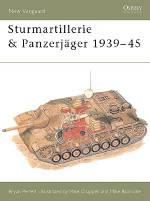 |
New Vanguard 34
STURMARTILLERIE and Panzerjager 1939-45 Originally the German assault gun was designed as an infantry support weapon, but the changing conditions of the battlefields of the Second World War forced it to adapt to perform a number of different roles, most importantly as a tank destroyer, although the infantry support role was never wholly discarded. If the much-glamorized Panzer divisions were the sword of the German army then the assault gun and tank destroyer units were its shield. As the Panzers' grip on the battlefield began to fail, though, it was left to the assault gun and tank destroyer crews to take up the burden. |
Bryan Perrett |
||
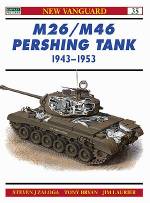 |
New
Vanguard 35 M26/M46 Persing Tank 1945-53 From the moment that the M4 Sherman had been matched against German Panther and Tiger tanks, the American tank crews had known that their vehicles were outclassed by the opposition. What was needed was a more powerful tank, more heavily armed and armored, that could take-on the powerful German panzers on a more equal footing. Although it took time to develop by the latter months of the war numbers of M26 Pershing tanks were reaching the frontline US armored units. Well armored and with a powerful 90mm gun the Pershing was a match for any tank in the German order of battle. |
Steven J.Zaloga |
||
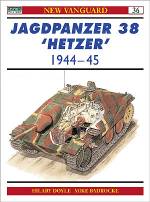 |
New
Vanguard 36
Jagdpanzer 38 Hetzer 1944-45 The Jagdpanzer 38 is one of the best known German armoured fighting vehicles from World War II. Rushed into series production in the record time of less than four months, it was instantly recognizable by its sleek appearance created by well sloped armour. Many experts in post-war armour hold the opinion that this tank destroyer was just the answer to Germany's problem of dealing with the numerically superior American M4 Medium tank (known to the British Army as the Sherman) and the Russian T-34. |
Hilary Doyle |
||
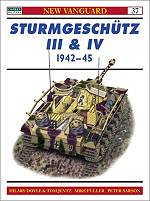 |
New
Vanguard 37
STURMGESCHÜTZ III & IV 1942-45 As the Second World War dragged on, heavy German losses in armoured vehicles and tanks ensured that assault gun units had to play an increasingly vital role in supporting the beleaguered infantry and countering Allied armour, particularly on the Eastern Front. The Sturmgeschütz was one of the most numerously produced and effectively deployed of the German armoured vehicles. Total production of the Ausf. G alone was close to 7,000 vehicles; a further 1,299 were equipped with the 10.5 cm gun as self-propelled howitzers. This book reveals how the Sturmgeschütz provided the backbone of Germany's armoured forces in every theatre and on every front during the long fighting-retreat of the final years of the war. |
Bryan Perrett |
||
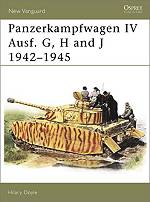 |
New
Vanguard 39
Panzerkampfwagen IV Ausg G,H and J - 1942-45 The Panzerkampfwagen IV was one of the most numerous and successful German tanks of World War II. Despite the introduction of the Panther and Tiger tanks, the PzKpfw IV remained the backbone of the German armoured units until the end of the war. This book details all of the variants of the Panzerkampfwagen IV with the long guns 7.5cm KwK 40 L/43 and L/48. Until 1942 armed with a short 7.5cm KwK L/24, it was used primarily in an infantry support role. However with the upgrading to the long 7.5cm it became the main battle tank of the Panzer Divisions. |
H.Doyle T.Jentz |
||
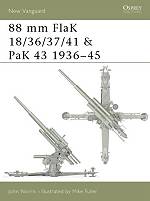 |
New
Vanguard 46
88mm Flak 18/36/37/41 and PaK 43 - 1936 - 45 The German 88 mm was by far the most famous and versatile artillery weapon of World War II. It was first used as an anti-aircraft weapon by the Condor Legion during the Spanish Civil War and saw further service in the German invasions of Poland and France, where it was first used in its anti-tank role. This role was particularly successful and the 88 became feared by tank crews from North Africa to Russia. Apart from these two main roles the 88 mm was used as the main weapon on late-war German tanks, as a self-propelled gun, and even as an aerial weapon. This book covers all these variants, explaining their design, development and operational use. |
John Norris |
||
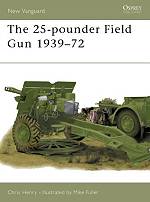 |
New
Vanguard 48
The 25 pounder field gun 1939-72 Of all the British guns in use during the Second World War, the 25 pounder is the gun that best represents Britain's armed forces. It was adaptable, it packed a powerful punch, and above all it was reliable. This book provides a full combat history of a gun that was used in every theatre of the Second World War and saw extensive service in the postwar years, particularly in Korea and during the Malaysian emergency. The last 25-pounder gun to see action in the British Army was one used by SAS troops at Mirbat, Oman, in 1972. |
Chris Henry |
||
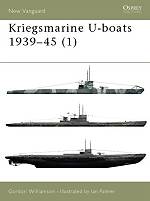 |
New
Vanguard 51
Kriegsmarine U-boats 1939-45 (Part 1) This, the first of two volumes on Germany's World War II U-boats, traces their development from the early U-boats of the Kaiser's Navy, the prohibition on Germany having U-boats following the Armistice in 1918 and the subsequent Treaty of Versailles, the secret development of U-boats using a 'cover-firm' in Holland, culminating in the formation of the 1st U-boat Flotilla in 1935 with the modern Type II. The operational history section includes examples from the Classes Type VIIA, Type VIIB, VIID, VIIE and VIIF before concentrating on the mainstay of the U-boat arm, the Type VIIC. Comparisons are also made with the standard allied submarines, their strengths, weaknesses and U-boat tactics. |
Gordon Williamson |
||
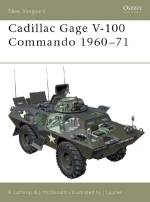 |
New
Vanguard 52
Cadillac Gage-V100 Commando 1960-71 Destined to become one of the most influential postwar armored cars, the V-100 Commando was developed by the Cadillac Gage Company in 1962 as a private venture, and the first prototype was completed in the same year. It was designed as a multi-purpose vehicle and could function as an 11-man personnel carrier, reconnaissance vehicle, convoy escort, command or patrol car and a riot vehicle. The V-100 was tested and evaluated in Vietnam before full-scale production began in 1964. It saw widespread use in Vietnam by both US and South Vietnamese forces. This title describes the design, development and operational use of the V-100 Commando, including their continued deployment around the world. |
Steven J.Zaloga |
||
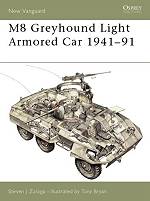 |
New
Vanguard 53
M8 Greyhound light armored car 1941-91 The M8 light armored car was the only significant wheeled combat vehicle used by the US Army in World War II. In conjunction with the lightly armed utility version, the M20, it was the staple of the army's cavalry squadrons for use in reconnaissance and scouting. First entering combat in Italy in 1943, it was widely used throughout the campaign in northwest Europe, though its off-road performance was found to be wanting. This title describes the design and development of the M8, covering the many variants that were produced during World War II and afterwards, along with a comprehensive survey of its operational use. |
Steven J.Zaloga |
||
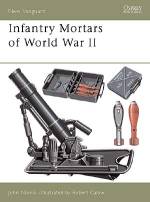 |
New
Vanguard 54 Infantry Mortar of World War II The mortar has proved to be one of the most influential and prevalent infantry support weapons of the 20th century. Throughout the course of World War II many different varieties of this weapon were used by the six main armies of the war: Britain, the USA, the Soviet Union, Germany Italy and Japan. Although the concept of the mortar was similar throughout these armies, calibers and usage varied enormously, dependent upon tactical use and terrain. This title covers all variants from the British 3-in.-equipped 'Heavy Weapon Companies', through to the Soviet12cm mortars, which were incorporated into the Tank Corps for the storming of Berlin in 1945. |
John Norris | ||
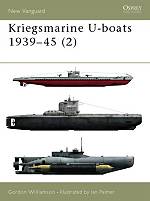 |
New
Vanguard 55 Kriegsmarine U-boats 1939-45 (Part 2) This title follows from New Vanguard 51: Kriegsmarine U-boats 1939–45 (1) and charts the continuing development of the U-boat in German service, including the evolution of the Type IX as a long range 'cruiser' intended for solo operations in distant waters. Also covered is the revolutionary Type XXI, conceived of in 1942 and launched in April 1944, the first true submarine rather than submersible, whose arrival was just too late to influence the war. Other vessels covered are the Type XXIII, a small vessel armed with only two torpedoes but technically highly advanced, and the Type X minelayers, which were rarely used in their intended role and more often used as supply boats. |
Gordon Williamson |
||
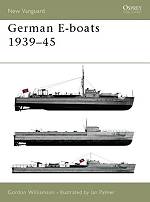 |
New
Vanguard 59
German E-boats 1939-45 By the outbreak of World War II, Germany had done much to replace the Kaiser's High Seas Fleet, which was scuttled following their surrender at the end of World War I. Forced to build anew, the Kriegsmarine possessed some of the most technically advanced warships in existence. Although the heavy units of the fleet were too small in number to pose much of a threat, Germany was particularly well served by her Navy's smaller vessels, in particular the U-Boats and the S-Boats. Known to the allies as the E-Boats ('Enemy'), they performed sterling duties in the Black Sea and English Channel, where they became a particular scourge. |
Gordon Williamson |
||